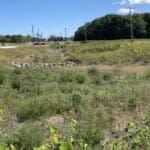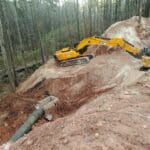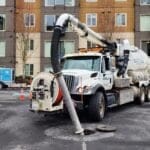County of Erie
The Western New York Stormwater Coalition: A Partnership to Protect Water Quality
A number of communities in Erie and Niagara counties have joined together to develop a stormwater management program to protect waterways and enhance the quality of life in their region. Forty-two municipal entities belong to the Western New York Stormwater Coalition. The Coalition’s Municipal Reference Guide lists the members and contact information for their respective Stormwater Management Programs.
Of the total sixty-two cities* in New York State which contain all municipalities incorporated as cities, the following are in Erie County and participate in the Western New York Stormwater Coalition:
- Buffalo Erie 261,025*
- Lackawanna Erie 18,121*
- Tonawanda Erie 15,112*
*Population estimate of 2011 census. (Source: Wikipedia)
The Western New York Stormwater Coalition (WNYSC) is a forum for these regulated communities to share resources and work in partnership toward compliance with the United States Environmental Protection Agency (U.S. EPA) Phase II Stormwater requirements. The overall goal of the Coalition is to utilize regional collaboration to identify existing resources and develop programs to reduce the negative impacts of stormwater pollution. The purpose of the public outreach website is to enhance public knowledge and awareness of stormwater pollution and provide information to individuals, households, and businesses to prevent stormwater pollution and protect water quality.
In addition to the Stormwater Management Plan (SWMP) created by the WNY Stormwater Coalition, the City of Buffalo has prepared its own SWMP modeled off the WNYSC one. The City of Buffalo’s municipal code has a slight reference to stormwater in Chapter 326: Plumbing, Article IV: Stormwater Retention System. The WNYSC and Buffalo SWMPs are the authoritative guides for stormwater runoff management in the City of Buffalo.
The municipal codes in Tonawanda and Lackawanna specifically address stormwater runoff associated with developed properties and explain requirements such as: Stormwater Pollution Prevention Plans (SWPPPs); Performance and design criteria; Maintenance, inspection and repair of stormwater facilities; and Administration and enforcement procedures.
These two codes were developed in concert and are very similar. Referenced below the City of Buffalo’s excerpt of municipal code are summaries and links to view the two ordinances.
City of Buffalo Municipal Code:
Article IV: Stormwater Retention System
[Adopted 7-20-2004, effective 8-2-2004]
§ 326-29 Stormwater retention.
A. All new parking lots or other new paved and drained areas where the collected stormwater load would surpass that of the sewer system into which it would discharge shall have a complete stormwater retention system designed by an architect or engineer and approved by the Chief Plumbing Inspector and the Sewer Authority, as part of their construction.
B. In all cases where a change in the potential peak amount of stormwater collected from a paved and drained parking lot, other paved and drained area, or drained collection area would create a new stormwater load that would be larger than the load capacity of the storm drainage system through which, or the sewer system into which, it discharges, a complete stormwater retention system designed and drawn by an architect or engineer and approved by the Chief Plumbing Inspector and the Sewer Authority shall be installed.
City of Lackawanna, NY
Chapter 230. ZONING – Article XII. Stormwater Management
[Added 2-5-2008]
§ 230-90. Findings; purpose.
B. Purpose. The purpose of this article is to establish minimum stormwater management requirements and controls to protect and safeguard the general health, safety, and welfare of the public residing within this jurisdiction and to address the findings of fact in§ 230-90A of this article. This article seeks to meet those purposes by achieving the following objectives:
- Meet the requirements of minimum measures 4 and 5 of the SPDES General Permit for Stormwater Discharges From Municipal Separate Storm Sewer Systems (MS45), Permit No. GP-02-02, or as amended or revised;
- Require land development activities to conform to the substantive requirements of the SPDES General Permit for Stormwater Discharges From Construction Activity, Permit No. GP-02-01, or as amended or revised;
- Minimize increases in stormwater runoff from land development activities in order to reduce flooding, siltation, increases in stream temperature, and streambank erosion and maintain the integrity of stream channels;
- Minimize increases in pollution caused by stormwater runoff from land development activities which would otherwise degrade local water quality;
- Minimize the total annual volume of stormwater runoff which flows from any specific site during and following development to the maximum extent practicable; and
- Reduce stormwater runoff rates and volumes, soil erosion and nonpoint source pollution, wherever possible, through stormwater management practices and ensure that these management practices are properly maintained and eliminate threats to public safety.
§ 230-95. Performance and design criteria.
All land development activities shall be subject to the following performance and design criteria:
A. Technical standards. For the purposes of this article, the following documents shall serve as the official guides and specifications for stormwater management. Stormwater management practices that are designed and constructed in accordance with these technical documents shall be presumed to meet the standards imposed by this article:
- The Design Manual; and
- The Erosion Control Manual.
B. Equivalence to technical standards. Where stormwater management practices are not in accordance with technical standards, the applicant or developer must demonstrate equivalence to the technical standards set forth in§ 230-9sA of this article and the SWPPP shall be prepared by a licensed professional.
C. Water quality standards. Any land development activity shall not cause an increase in turbidity that will result in substantial visible contrast to natural conditions in surface waters of the state of New York.
§ 230-96. Maintenance, inspection and repair of stormwater facilities.
A. Maintenance and inspection during construction.
- The applicant or developer of the land development activity or his or her representative shall at all times properly operate and maintain all facilities and systems of treatment and control (and related appurtenances) which are installed or used by the applicant or developer to achieve compliance with the conditions of this article. Sediment shall be removed from sediment traps or sediment ponds whenever their design capacity has been reduced by 50%.
- For land development activities meeting Condition A, B or C in§ 230-94B(2) of this article, the applicant shall have a qualified professional conduct site inspections and document the effectiveness of all erosion and sediment control practices every seven days and within 24 hours of any storm event producing 0.5 inch of precipitation or more. Inspection reports shall be maintained in a site logbook.
B. Maintenance easement(s). Prior to the issuance of any approval that has a stormwater management facility as one of the requirements, the applicant or developer must execute a maintenance easement agreement that shall be binding on all subsequent landowners served by the stormwater management facility. The easement shall provide for access to the facility at reasonable times for periodic inspection by the City to ensure that the facility is maintained in proper working condition to meet design standards and any other provisions established by this article. The easement shall be recorded by the granter in the office of the County Clerk after approval by the counsel for the City.
C. Maintenance after construction. The owner or operator of permanent stormwater management practices installed in accordance with this article shall ensure they are operated and maintained to achieve the goals of this article. Proper operation and maintenance also includes, as a minimum, the following.
- A preventive/corrective maintenance program for all critical facilities and systems of treatment and control (or related appurtenances) which are installed or used by the owner or operator to achieve the goals of this article.
- Written procedures for operation and maintenance and training new maintenance personnel.
- Discharges from the SMPs shall not exceed design criteria or cause or contribute to water quality standard violations in accordance with § 230-95 of this article.
- Maintenance agreements. The City shall approve a formal maintenance agreement for stormwater management facilities binding on all subsequent landowners and recorded in the office of the County Clerk as a deed restriction on the property prior to final plan approval. The maintenance agreement shall be consistent with the terms and conditions of Appendix A of this chapter entitled *Sample Stormwater Control Facility Maintenance Agreement. The City, in lieu of a maintenance agreement, at its sole discretion, may accept dedication of any existing or future stormwater management facility, provided such facility meets all the requirements of this article and includes adequate and perpetual access and sufficient area, by easement or otherwise, for inspection and regular maintenance.
§ 230-97. Administration and enforcement; penalties for offenses; fees.
(2) Stormwater management practice inspections. The SMO is responsible for conducting inspections of SMPs. All applicants are required to submit as-built plans for any SMPs located on-site after final construction is completed. The plan must show the final design specifications for all stormwater management facilities and must be certified by a professional engineer.
(3) Inspection of stormwater facilities after project completion. Inspection programs shall be established on any reasonable basis, including but not limited to: routine inspections; random inspections; inspections based upon complaints or other notice of possible violations; inspection of drainage basins or areas identified as higher-than-typical sources of sediment or other contaminants or pollutants; inspections of businesses or industries of a type associated with higher-than-usual discharges of contaminants or pollutants or with discharges of a type which are more likely than the typical discharge to cause violations of state or federal water or sediment quality standards or the SPDES stormwater permit; and joint inspections with other agencies inspecting under environmental or safety laws. Inspections may include, but are not limited to: reviewing maintenance and repair records; sampling discharges, surface water, groundwater, and material or water in drainage control facilities; and evaluating the condition of drainage control facilities and other stormwater management practices.
C. Enforcement and penalties.
(1) Notice of violation. When the City determines that a land development activity is not being carried out in accordance with the requirements of this article, it may issue a written notice of violation to the landowner. The notice of violation shall contain:
- The name and address of the landowner, developer or applicant;
- The address, when available, or a description of the building, structure or land upon which the violation is occurring;
- A statement specifying the nature of the violation;
- A description of the remedial measures necessary to bring the land development activity into compliance with this article and a time schedule for the completion of such remedial action;
- A statement of the penalty or penalties that shall or may be assessed against the person to whom the notice of violation is directed; and
- A statement that the determination of violation may be appealed to the City Council by filing a written notice of appeal within 15 days of service of notice of violation.
STORMWATER MANAGEMENT PLAN
November 2010 -Western NY Stormwater coalition
SPDES General Permit for Stormwater Discharges from Municipal Separate Storm Sewer Systems
GP-0-10-002, May 1, 2010 – April 30, 2015
The Western New York Stormwater Coalition (WNYSC) Stormwater Management Program (SWMP) Plan has been developed to comply with the New York State Department of Environmental Conservation General Permit for Stormwater Discharges from Municipal Separate Storm Sewer Systems (GP-0-10-002). It is a shared SWMP Plan providing policy and management guidance to the regulated municipalities and agencies that are members of the WNYSC.
The Cities of Buffalo, Lackawanna, and Tonawanda are members of the Western New York Stormwater Coalition and are participating parties to this SWMP Plan. In addition, there are thirty-nine municipal other entities that belong to the Western New York Stormwater Coalition.
| -Buffalo Sewer Authority |
–Town of Aurora |
–Town of Lewiston |
-Village of Depew |
| -City of Lackawanna |
-Town of Boston |
-Town of Niagara |
-Village of East Aurora |
| -City of North Tonawanda |
-Town of Cambria |
-Town of Orchard Park |
-Village of Hamburg |
| -City of Tonawanda |
-Town of Cheektowaga |
-Town of Pendleton |
-Village of Kenmore |
| -Erie County Department of Public Works |
-Town of Clarence |
-Town of Porter |
-Village of Lancaster |
| -Erie County Sewer District #6 |
-Town of Eden |
-Town of Tonawanda |
-Village of Lewiston |
| -Niagara County |
-Town of Elma |
-Town of West Seneca |
-Village of Orchard Park |
| -Niagara Falls Water Board |
-Town of Evans |
-Town of Wheatfield |
-Village of Sloan |
| -State University of New York at Buffalo |
-Town of Grand Island |
-Village of Alden |
-Village of Williamsville |
| -Town of Alden |
-Town of Hamburg |
-Village of Angola |
-Village of Youngstown |
| -Town of Amherst |
-Town of Lancaster |
-Village of Blasdell |
|
The SWMP Plan is based on the Federal Stormwater Phase II rule, issued in 1999, which requires municipal separate storm sewer system (MS4) owners and operators, in U.S. Census-defined urbanized areas, to develop a Stormwater Management Program. There are six program elements designed to reduce the discharge of pollutants to the maximum extent practicable. The program elements, titled Minimum Control Measures, include:
- Public Education and Outreach
- Public Involvement / Participation
- Illicit Discharge Detection and Elimination
- Construction Site Runoff Control
- Post-Construction Stormwater Management
- Pollution Prevention / Good Housekeeping for Municipal Operations.
Each Minimum Control Measure and the Best Management Practices that have been implemented to maintain compliance with the NYSDEC GP-0-10-002 General Permit are described in the plan. For each Best Management Practice, responsibilities to achieve and sustain compliance are clearly defined. Portions of the work necessary are provided through the collective efforts of the Western New York Stormwater Coalition members. Completion of the remaining work is the responsibility of the City of Buffalo’s designated Stormwater Management Officer.
This SWMP Plan should be updated on an annual basis in order to take into consideration the latest technologies and information to maintain compliance with the NYSDEC GP-0-10-002 General Permit.
SECTION 5 – POST-CONSTRUCTION STORMWATER MANAGEMENT
5.1 Description of Minimum Control Measure
The Post-Construction Stormwater Management minimum control measure consists of Best Management Practices (BMPs) that focus on the prevention or minimization of water quality impacts from new development and redevelopment projects that disturb greater than or equal to one acre, including projects less than one acre that are part of a larger common plan of development or sale that discharge into the MS4. The BMPs describe structural and/or non-structural practices; the legal authority mechanism that will be used to address post-construction runoff from new development and redevelopment projects; and procedures to ensure long term operation and maintenance of BMPs.
As per Criterion 3 of the Designation Criteria, Part II.F and defined in Part X.B of GP-0-10-002, operators of traditional land use control MS4s must extend the implementation of MCM 5 to its full jurisdiction.
5.2 General Permit Requirements
An MS4 must, at a minimum:
a. Develop, implement, and enforce a program that:
- provides equivalent protection to the NYS SPDES General Permit for Stormwater Discharges from Construction Activities (either GP-02-01 or GP-0-08-001 or GP-0-10-001), unless more stringent requirements are contained within the general SPDES permit;
- addresses stormwater runoff from new development and redevelopment projects to the small MS4 from projects that result in a land disturbance of greater than or equal to one acre. Control of stormwater discharges from projects of less than one acre must be included in the program if:
- that project is part of a larger common plan of development or sale; or
- if controlling such activities in a particular watershed is required by the Department;
- includes a law, ordinance or other regulatory mechanism to require postconstruction runoff controls from new development and re-development projects to the extent allowable under State law that meet the State’s most current technical standards:
- the mechanism must be equivalent to one of the versions of the NYSDEC Sample Local Laws for Stormwater Management and Erosion and Sediment Control”; and
- equivalence must be documented:
- by adoption of one of the sample local laws without changes;
- by using the NYSDEC Gap Analysis Workbook; or
- by adoption of a modified version of the sample local law, or an alternative law, and, in either scenario, certification by the attorney representing the small MS4 that adopted law is equivalent to one of the versions of the sample local law;
- includes a combination of structural management practices (according to standards defined in the most current version of the NYS Stormwater Management Design Manual) that will reduce the discharge of pollutants to the MEP. In the development of watershed plans, municipal comprehensive plans, open space preservation programs, local law, ordinances and land use regulations, permittees must consider principles of Low Impact Development (LID), Better Site Design (BSD) and other Green Infrastructure practices to the MEP. In the development of the watershed plans, municipal comprehensive plans, open space preservation programs, local law, ordinances and land use regulations, permittees must consider smart growth principles, natural resource protection, impervious area reduction, maintaining natural hydrologic conditions in developments, riparian buffers or set back distances for protection of environmentally sensitive areas such as streams, wetlands, and erodible soils.
- Permittees are required to review according to the Green Infrastructure practices defined in the Design Manual at a site level, and are encouraged to review, and revise where appropriate, local codes and laws that include provisions that preclude green infrastructure or construction techniques that minimize or reduce pollutant loadings.
- if a stormwater management practice is designed and installed in accordance with the New York State Stormwater Management Design Manual or has been demonstrated to be equivalent and is properly operated and maintained, then MEP will be assumed to be met for post-construction stormwater discharged by the practice;
- describes procedures for SWPPP review with consideration of potential water quality impacts and review of individual SWPPPs to ensure consistency with state and local post-construction stormwater requirements;
- ensure that the individuals performing the reviews are adequately trained and understand the State and local post construction stormwater requirements;
- ensure that the individuals performing the reviews for SWPPPs that include post-construction stormwater management practices are qualified professionals or under the supervision of a qualified professional (as defined in GP-0-10-002);
- all SWPPPs must be reviewed for sites where the disturbance is one acre or greater; and
- after review of SWPPPs, the permittee must utilize the “SWPPP Acceptance Form” created by the Department and required by the SPDES General Permit for Stormwater Discharges from Construction Activity (GP-0-10-001) when notifying construction site owner / operators that their plans have been accepted and approved by the permittee;
- utilize available training from sources such as Soil and Water Conservation Districts, Planning Councils, the New York State Department of State, USEPA, and/or NYSDEC to educate municipal boards, and Planning and Zoning Boards on low impact development principles, better site design approach, and green infrastructure applications.
- maintain an inventory of post-construction stormwater management practices within the permittees jurisdiction. At a minimum, include practices discharging to the small MS4 that have been installed since March 10, 2003, all practices owned by the small MS4, and those practices found to cause or contribute to water quality standard violations.
- the inventory shall include at a minimum: location of practice (street address or coordinates); type of practice; maintenance needed per the NYS Stormwater Management Design Manual, SWPPP, or other provided documentation; and dates and type of maintenance performed; and
- ensures adequate long-term operation and maintenance of management practices identified in Item vi (above) by trained staff, including inspection to ensure that practices are performing properly.
- The inspection shall include inspection items identified in the maintenance requirements (NYS Stormwater Management Design Manual, SWPPP, or other maintenance information) for the practice. Permittees are not required to collect stormwater samples and perform specific chemical analysis;
- Permittees may include in the SWMP Plan provisions for development of a banking and credit system. MS4s must have an existing watershed plan based on which offsite alternative stormwater management in lieu of or in addition to on-site stormwater management practices are evaluated. Redevelopment projects must be evaluated for pollutant reduction greater than required treatment by the state standards. The individual project must be reviewed and approved by the Department. Use of a banking and credit system for new development is only acceptable in the impaired watersheds to achieve the no net increase requirement and watershed improvement strategy areas to achieve pollutant reductions in accordance with watershed plan load reduction goals. A banking and credit system must at minimum include:
- Ensure that offset exceeds a standard reduction by factor of at least 2
- Offset is implemented within the same watershed
- Proposed offset addresses the POC of the watershed
- Tracking system is established for the watershed
- Mitigation is applied for retrofit or redevelopment
- Offset project is completed prior to beginning of the proposed construction
- A legal mechanism is established to implement the banking and credit system
b. Develop, implement, and provide adequate resources for a program to inspect development and re-development sites by trained staff and to enforce and penalize violators;
c. Develop, record, periodically assess and modify as needed measurable goals; and
d. Select appropriate post-construction stormwater BMPs and measurable goals to ensure the reduction of all POCs in stormwater discharges to the MEP.
5.3 Methodology for Compliance with Permit Requirements
All participating MS4s in the WNYSC have adopted NYS’s Sample Local Law for Stormwater Management and Erosion & Sediment Control which includes provisions to enforce a program that reduces pollutant runoff from newly developed and redeveloped sites. Each MS4 will be responsible for inspecting the sites for proper operation and maintenance and enforcing the permit requirements for properties that are not in compliance. In this manner, the MS4 can ensure adequate long-term management practices for both public and private facilities.
5.4 Best Management Practices:
5.4.1 Regulatory Mechanism for Stormwater Management and Erosion & Sediment Control
Description / Methodology
A stormwater management law, ordinance or other regulatory mechanism is required under GP-0-10-002. The law, ordinance or other regulatory mechanism must be equivalent to New York State’s Sample Local Law for Stormwater Management and Erosion & Sediment Control and be certified as such by an attorney representing the MS4.
· The regulatory mechanism establishes minimum stormwater management requirements and controls to protect the general health, safety, and welfare of the public. In addition to construction-related stormwater issues, the revised Regulation addresses long term management of post-construction stormwater practices.
Annual Compliance Requirements
WNYSC
Develop inspection forms and procedures necessary to inspect local new and redevelopment projects in order to ensure compliance with local post-construction runoff regulations and approved plans.
Train inspection personnel on local post-construction runoff regulations and final inspection procedures.
————————————–
Links
City of Lackawanna Stormwater Ordinance
Additional Erie County Stormwater Management Documents
 Kenosha, Wis. Highway KR Regenerative Stormwater ConveyanceThe Root-Pike Watershed Initiative Network Kenosha County, and others worked with AQUALIS to design and implement an innovative solution for stormwater control along Highway KR.
Kenosha, Wis. Highway KR Regenerative Stormwater ConveyanceThe Root-Pike Watershed Initiative Network Kenosha County, and others worked with AQUALIS to design and implement an innovative solution for stormwater control along Highway KR. Durham, N.C. Sinkhole Leads to Stormwater System RehabilitationThe tenant on this property noticed a depression that opened to the ground below and notified the property owners.
Durham, N.C. Sinkhole Leads to Stormwater System RehabilitationThe tenant on this property noticed a depression that opened to the ground below and notified the property owners.
